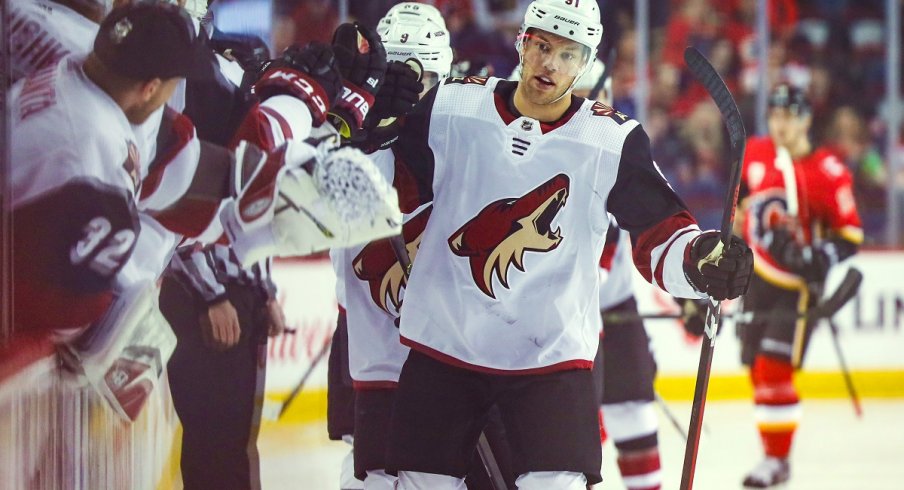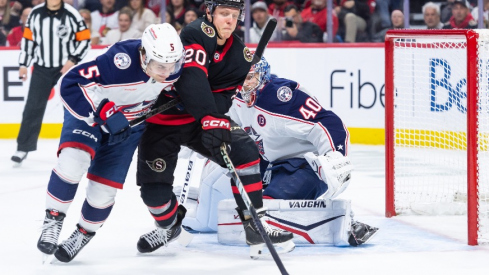Arizona Coyotes star left-winger Taylor Hall is the marquee forward UFA on the market this fall and the Columbus Blue Jackets need scoring help.
Seems like a match made in heaven, right?
Maybe, but it's more nuanced than that. Here are the pros and cons of pursuing the former NHL MVP.
PROS
Hall, who the Coyotes acquired from the New Jersey Devils on December 16, is said to be prioritizing a winning culture over garages money, which could benefit a team like Columbus. Here's what Sportsnet's Chris Johnston said during the Headlines segment on Hockey Night In Canada:
“His focus is far more on finding a stable, winning situation where he fits in well. With it being such unusual times around COVID-19, and I think with Hall playing 10 seasons now as an NHL player and only being in the playoffs for two of them, he’s looking to find a winning place to land, maybe more than a place that might fill his bank account up most.”
Columbus is one of just six organizations that have played postseason hockey in four consecutive seasons. And while they haven't been past the second round, neither has Hall. The Blue Jackets are a young team that needs elite offensive players to get to the next level. Again, that seems like a happy marriage.
Even if cash isn't his priority, he'll still be paid a pretty penny. And with a flat salary cap in 2020-21 and beyond, several would-be suitors will be priced out before the bidding begins. The Blue Jackets are better positioned than most teams to navigate life with a flat cap, thanks to GM Jarmo Kekalainen's economical contract negotiations.
But let's get down to brass tacks. The Blue Jackets forward group scored the second-fewest goals in the NHL last year, trailing only the disastrous Detroit Red Wings (how fun was that to type?!). They need offense. Hall provides offense. The 28-year-old would immediately become the club's best offensive player and would (again) give Pierre-Luc Dubois a high-end winger.
No changes expected.#CBJ | @BlueTech_Inc pic.twitter.com/0ZRgKPOaB9
— Columbus Blue Jackets (@BlueJacketsNHL) August 19, 2020
Equally importantly, it would push players into more appropriate roles. While the future is bright for Alexandre Texier, 1LW is a bit rich for his blood at this stage of his career. That's not a knock on the young Frenchman; if anything, it's a compliment that he's already thrust into such a significant role. Texier in a lesser role would push down other left-wingers, like Gustav Nyquist and Nick Foligno, into more appropriate slots. The above depth chart, used in the Game 5 loss to Tampa Bay, would simply be more imposing with Hall.
CONS
Even with that said, there are a number of factors that make Hall a less-than-ideal candidate. First: which Hall would the Blue Jackets be receiving? The NHL's 2017-18 MVP, who put up 39-54-93 in 76 games? Or the winger who tallied 16-36-52 in 65 games this season. He was Arizona's top forward by a mile in the qualifying round, adding 2-4-6 in nine games. Still, it's not like he lit the world on fire. And while counting stats are certainly just one component in the larger equation, the simple truth is that the Blue Jackets need goals. Hall's eclipsed 30 goals just once - his MVP season.
Columbus is looking to take the next step in the postseason. Adding Hall could certainly help that, but adding a player with 14 career playoff games in 10 NHL seasons is not a ringing endorsement. It's not like he's proven himself over long playoff stints. air or not, his team's continued lack of playoff success (or presence?) is worth examining.
It's safe to say that, between the salary cap realities caused by the global pandemic and Hall's good - not great - season, Hall lost money in the past several seasons. Had he been a UFA after his Hart Trophy season, he would have cashed in for $10M a year payday, no questions asked (he still may, but it would be more of a surprise). So let's say he comes in around $8M AAV. That's still a hefty chunk of money to pay for a player that is far from a sure-fire home run. That, and the fact that he'll be 29 when his contract kicks in leaves some room for concern. That isn't to say he wouldn't be worth the cost. It is to say that he may not be for much longer.
While Hall is the most notable free-agent forward, there are cheaper options. Tyler Toffoli, Mike Hoffman, Evgeni Dadonov, and Vladislav Namestnikov are other winger options that would come in at a discounted rate. None of these players is a perfect fit, but neither is Hall.
The reason none of these players is a perfect fit is that the Blue Jackets have plenty of winger depth but lack high-end center depth. Hall doesn't change that, and in fact, only more sharply distorts the wealth gap between the two positions. The Blue Jackets already have too many wingers.
One tack the Bleu Jackets could try is to redefine what it means to play center in their system. Vegas doesn't wow anyone with their center depth chart but still see excellent results from their centermen because they are relied upon for less. Instead, the heavier lifting falls on their impressive winger group. As it stands, Columbus is staring at another season of Dubois, Boone Jenner, Alexander Wennberg, and Riley Nash/Kevin Stenlund down the middle (though it's true that Texier could move to the middle). That doesn't inspire confidence.
It's not a given that there's enough money in the budget to make such a splash. Aside from Dubois, Vladislav Gavrikov and Josh Anderson are RFAs. Dubois will likely become the team's highest-paid player. Gavrikov and Anderson, should he choose to stay Columbus, will command a hefty promotion as well.
Conclusion
Hall isn't a perfect UFA candidate for the Blue Jackets. Kekalinanen has already said he doesn't anticipate being a major player in UFA, and it's easy to understand the rationale. He's not the high-end, pure goal scorer that the organization covets. He plays the same position that the Blue Jackets already have in spades. And being the preeminent UFA forward, he'll cost a pretty penny.
On the other hand, the Blue Jackets have made it to the playoffs in four straight seasons but don't have the offensive horses to get over the hump. Perhaps they'll live with the old adage: Don't let good be the enemy of great.

